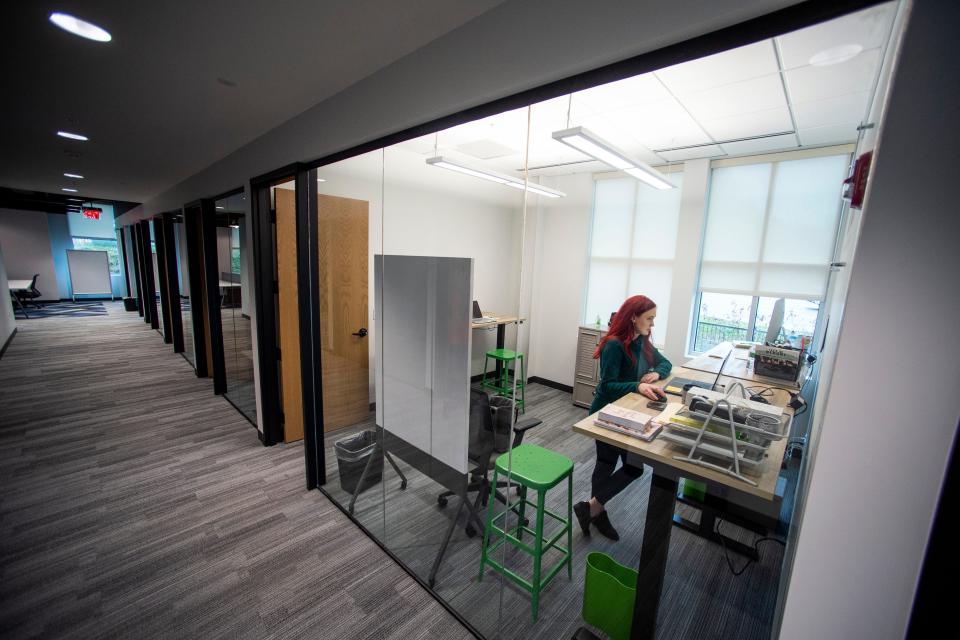2023 was the year return-to-office died. Experts share remote-work trends expected in 2024
Remote-work numbers have dwindled over the past few years as employers issue return-to-office mandates. But will that continue in 2024?
The numbers started to slide after spring 2020, when more than 60% of days were worked from home, according to data from WFH Research, a scholarly data collection project. By 2023, that number had dropped to about 25% ? much lower than its peak but still a fivefold increase from 5% in 2019.
But work-from-home numbers have held steady throughout most of 2023. And according to remote-work experts, they're expected to rebound in the years to come as companies adjust to work-from-home trends.
“Return-to-office died in ‘23,” said Nick Bloom, an economics professor at Stanford University and work-from-home expert. “There’s a tombstone with 'RTO' on it.”
Here are other remote-work forecasts looking ahead into the new year.

Companies figure out the hybrid model
Though a number of companies issued return-to-work mandates this year, most are allowing employees to work from home at least part of the week. That makes 2024 the year for employers to figure out the hybrid model.
“We’re never going to go back to a five-days-in-the-office policy,” said Stephan Meier, professor of business at Columbia University. “Some employers are going to force people to come back, but I think over the next year, more and more firms will actually figure out how to manage hybrid well.”
Thirty-eight percent of companies require full-time in-office work, down from 39% one quarter ago and 49% at the start of the year, according to software firm Scoop Technologies.
Barbara Larson, an executive professor of management at Northeastern University, said too many companies have been focused on the number of days spent out of the office and not how to manage employees while they're away. For her, “that’s the clear next step.”
Because work-from-home productivity varies among employees, Larson said, companies may start to develop more nuanced remote-work policies that aren’t one-size-fits-all. So while a company may allow one employee to work remotely full-time, another may be required to be in the office three days a week.
"The fact is that good remote-work policies leave enough flexibility for there to be some form of performance-based adaptation," she said. "And that is harder to do than just having a kind of blanket, across-the-board policy."
How much is that remote job worth to you Americans will part with pay to work from home
Expect remote work numbers to remain flat in 2024, then pick back up
Bloom called remote-work numbers in 2023 “pancake-flat." Yes, large companies like Meta and Zoom made headlines by ordering workers back to the office. But, Bloom said, just as many other companies were quietly reducing office attendance to cut costs.
He expects the share of employees working from home to pick up as companies adjust to remote work, possibly starting as soon as 2025 or 2026. Imagine the chart mapping the data to look something like the Nike swoosh, he said.

“I think the numbers will gradually go up as this becomes more of an accepted norm as future generations grow up with it being so widely available, and as the technology for for doing it gets better,” said Julia Pollak, ZipRecruiter’s chief economist. Reluctant leaders aging out of the workforce will help, too, she said.
Though there’s a finite number of workers who have the option to work from home – one paper estimates 37% of the country’s jobs can be done entirely at home – Pollak said we could eventually see as much as 33% of the country's work days completed from home.
“Hybrid is going to be the new normal,” she said.
Better work-from-home technology
Improved technology also will help remote work figures rebound.
Pollak said she expects to see more companies invest in remote-work-enabling technology this year. Think state-of-the-art rooms built for Zoom meetings, with privacy glass that hides the screen from passersby.
“There’s been a bit of a pause in business investment about the past year, 18 months, but that’s likely to recover when (interest) rates come down,” Pollak said. “That will likely lead to investments in these technologies that make remote and hybrid work better.”
And five years down the road, Bloom said, offices may start implementing things like holograms and virtual reality devices to help remote employees connect.
"In the long run, the thing that really matters is technology."

Redesigned office spaces
Companies may use the new year to redesign office space to make employees' time in the office more efficient, Meier said. That means building out spaces that facilitate brainstorming sessions.
“If you go into the office, it should be all collaboration and social interaction," he said. "Once we figure that out, I think there is going to be an advantage to a hybrid workplace compared to a work where everybody comes to the office five days a week."
A new take on office building continues
Expect to see more cities address the new work trends in 2024.
Meier expects more cities to look at easing zoning laws and other regulations to make it easier to convert empty office space into apartment buildings, a move that could help revitalize city centers and ease the national housing shortage. The U.S. office vacancy rate hit a 30-year-high of 18.2% earlier this year, according to the commercial real estate services and investment firm CBRE.

We’ve already seen certain cities like San Francisco pass legislation that rolls back red tape to make office conversions easier. Meier expects other cities to follow.
“Cities have to reimagine themselves,” Meier said. “I expect 2024 and 2025, more cities are becoming really desperate.”
This article originally appeared on USA TODAY: Is work-from-home going away in 2024? Why experts don't think it will.